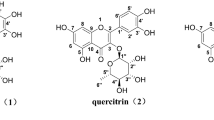Abstract
Elsholtzia splendens is a copper-tolerant plant species which grows on copper deposits in China. The generation of a valuable E. splendens biomass on specific contaminated sites has become one of the promising phytotechnologies. The simultaneous separations of apigenin, luteolin, and rosmarinic acid yielded in the ethyl acetate extracts of the flowering aerial parts was achieved by the use of a macroporous resin, polyamide, and silicagel columns during chromatography. Chemical identification confirmed the structures based on the spectra of FTIR, NMR, and HPLC/ESI-MS. The isolated compounds of purity above 98.3 % were evaluated for their in vitro cytotoxic activities against human cancer cell lines including A549 (non-small lung), A431 (skin), and Bcap37 (breast). Among these compounds, luteolin and apigenin presented the best cytotoxic activities against A549, A431, and Bcap37 cells and, therefore, both could be the valuable products for the post-harvest processing of E. splendens biomass.



Similar content being viewed by others
References
Bimakr M, Rahman RLA, Taip FS et al (2011) Comparison of different extraction methods for the extraction of major bioactive flavonoid compounds from spearmint (Mentha spicata L.) leaves. Food Bioprod Process 89:67–72
Chen H, Zuo YG, Deng YW (2001) Separation and determination of flavonoids and other phenolic compounds in cranberry juice by high-performance liquid chromatography. J Chromatogr A 913:387–395
Choi EJ, Kim GH (2008a) In vivo antioxidative characteristics of extracts from the aromatic herb Elsholtzia splendens. Food Sci Biotechnol 17:1128–1130
Choi EJ, Kim GH (2008b) Effect of Elsholtzia splendens extracts on the blood lipid profile and hepatotoxicity of the mice. Food Sci Biotechnol 17:413–416
Choi EJ, Lee YS, Kim GH (2007) Antioxidative characteristics of extracts from aromatic herb Elsholtzia splendens. Food Sci Biotechnol 16:489–492
Choi EJ, Kim T, Kim GH (2008) Antioxidant effects of Elsholtzia splendens extract on DMBA-induced oxidative stress in mice. Food Sci Biotechnol 17:1341–1344
Chung MS, Kim GH (2010) Effects of Elsholtzia splendens and Cirsium japonicum on premenstrual syndrome. Nutr Res Pract 4:290–294
Fu YJ, Zu YG, Liu W et al (2006) Optimization of luteolin separation from pigeonpea [Cajanus cajan (L.) Millsp.] leaves by macroporous resins. J Chromatogr A 1137:145–152
Guo ZQ, Liu ZZ, Wang XH et al (2012) Elsholtzia: phytochemistry and biological activities. Chem Cent J 6:147–153
Ke YK, Dong HR (1998) Spectroscopy, 3rd edn, Handbook of Analytical Chemistry. Chemical Industry Press, Beijing
Kim DW, Son KH, Chang HW et al (2003) Anti-inflammatory activity of Elsholtzia splendens. Arch Pharm Res 26:232–236
Makina T, Ono T, Liu N et al (2002) Suppressive effects of Rosmarinic acid on mesangioproliferative glomerulonephritis in rats. Nephron 92:898–904
Osakabe N, Yasuda A, Natsume M et al (2002) Rosmarinic acid, a major polyphenolic component of Perilla frutescens, reduces lipopolysaccharide (LPS)-induced liver injury in D-Galactosamine (D-GalN)-sensitized mice. Free Radic Biol Med 33:798–806
Pérez-Tortosa V, López-Orenes A, Martínez-Pérez A et al (2012) Antioxidant activity and rosmarinic acid changes in salicylic acid-treated Thymus membranaceus shoots. Food Chem 130:362–369
Petersen M, Simmonds MSJ (2003) Molecules of interest—rosmarinic acid. Phytochemistry 62:121–125
Samy RP, Gopalakrishnakone P, Ignacimuthu S (2006) Antitumor promoting potential of luteolin against 7,12-dimethylbenz(a)-anthracene-induced mammary tumors in rats. Chem-Biol Interact 164:1–14
Sanbonoi C, Takano H, Osakabe N et al (2003) Rosmarinic acid inhibits lung injury induced by diesel exhaust particles. Free Radic Biol Med 34:1060–1069
Shim SM, Choi MH, Kim GH (2008) Safety evaluation of Elsholtzia splendens extracts: assessment of acute toxicity and mutagenicity. Food Chem Toxicol 46:1042–1047
Siddique YH, Beg T, Afzal M (2008) Antigenotoxic effect of apigenin against anti-cancerous drugs. Toxicol In Vitro 22:625–631
Tang SR, Wilke BM, Huang CY (1999) The uptake of copper by plants dominantly growing on copper mining spoils along the Yangtze River, the People’s Republic of China. Plant Soil 209:225–232
Xie XJ, Xu ZB (1952) Elsholtzia haichouensis—an indicator of copper mine. Geol Acta 32:360–368 (in Chinese)
Xing Y, Peng HY, Zhang MX et al (2012) Caffeic acid product from the highly copper-tolerant plant Elsholtzia splendens post phytoremediation: its extraction, purification and identification. J Zhejiang Univ Sci B 13:487–493
Youn J, Lee KH, Won J et al (2003) Beneficial effects of rosmarinic acid on suppression of collagen induced arthritis. J Rheumatol 30:1203–1207
Yu DQ, Yang JS (1999) Nuclear magnetic resonance spectroscopy, 2nd edn, Handbook of Analytical Chemistry. Chemical Industry Press, Beijing
Acknowledgements
This work was supported by grants from the National Natural Science Foundation of China (NSFC, 21277121), China Scholarship Council (2011833072), and State Key Laboratory of Hydrology-Water Resources and Hydraulic Engineering, Hohai University (No. 2013491311) Zhejiang Provincial Natural Science Foundation of China (No. Z14B070005).
Conflict of interest
The authors have declared no conflict of interest.
Author information
Authors and Affiliations
Corresponding author
Additional information
Responsible editor: Elena Maestri
Electronic supplementary material
Below is the link to the electronic supplementary material.
ESM 1
(DOC 765 kb)
Rights and permissions
About this article
Cite this article
Peng, H., Xing, Y., Gao, L. et al. Simultaneous separation of apigenin, luteolin and rosmarinic acid from the aerial parts of the copper-tolerant plant Elsholtzia splendens . Environ Sci Pollut Res 21, 8124–8132 (2014). https://doi.org/10.1007/s11356-014-2747-5
Received:
Accepted:
Published:
Issue Date:
DOI: https://doi.org/10.1007/s11356-014-2747-5




